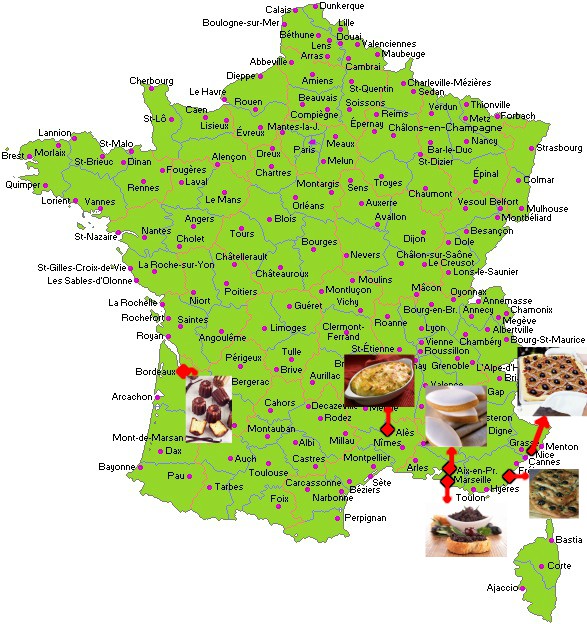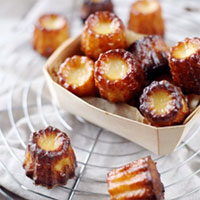Gastronomic specialties of southern France
 Hello everyone! This post is going to be all about gastronomic specialties from Provence and a little bit beyond. I love food and have been about a bit. You might say that I know a thing or two about the gastronomy in this region!
Hello everyone! This post is going to be all about gastronomic specialties from Provence and a little bit beyond. I love food and have been about a bit. You might say that I know a thing or two about the gastronomy in this region!
I grew up in a town in the Var region called Grimaud, which is about an hour and a half away from Aix-en-Provence. My paternal grandmother is from Toulon in Provence. My paternal grandfather grew up in Strasbourg and his family was from Bordeaux. My grandparents on my mother’s side are from Toulouse but have German origins.
I was born in a town in north-eastern France but moved to Grimaud in Provence when I was only a couple of months old. My paternal grandparents were near us, in the town of Cassis near Marseille at the time. We stayed in Grimaud for six years and then left Provence for Bordeaux, where I went to school for two years. I then spent the last three years of primary school in Toulouse, moving there following my parent’s divorce.
My father moved to Paris (and now considers himself a Parisian) and we stayed in Toulouse near our mother’s parents. However, my mother all of a sudden decided to move us to Frankfurt, in Germany. I was eleven and only spoke basic German at the time, my sisters knew even less of the language. We were kind of worried about the language barrier, but we made it! We were already fluent in German within only a few months in Frankfurt! I have a lot of relatives on both sides of the family. Dozens of cousins on my mum’s side and about twenty on my dad’s side.
I have at least one family member in every region, which is nice. Believe it or not, we somehow always manage to see most of them at least once a year!
That’s a little on my background, now let’s discover these gastronomic specialties:

Fougasse aux olives
 The first specialty I am going to write about is olive fougasse. Fougasse is a type of flat bread, livened up with olives which are applied to the surface of the bread before baking. Once cooked, the fougasse is eaten with an aperitif or as a side dish during meals. It is a great accompaniment for soup, salad or deli platters!
The first specialty I am going to write about is olive fougasse. Fougasse is a type of flat bread, livened up with olives which are applied to the surface of the bread before baking. Once cooked, the fougasse is eaten with an aperitif or as a side dish during meals. It is a great accompaniment for soup, salad or deli platters!
Where I am from, the traditional fougasse is the olive one, though some can also either contain diced bacon, anchovies or cheese. Fougasse is primarily savoury, but a sweet variation of it is the fougasse from the town of Aigues-Mortes in the Gard department. This version is slightly brioche-like and orange blossom flavoured.
Originally, the fougasse bread recipe was quickly made up to test the wood-fired oven in bakeries. Baking this first would make sure that the temperature was good, before baguettes & other types of bread went in the oven. The baked fougasse would then be used as a morning snack for apprentice bakers.
Nowadays, fougasse is sold in every bakery in Provence, markets, etc. It is my favourite thing to eat and is very popular! I grew up baking fougasse with my grandmother and was lucky enough to get her very own recipe. I am not allowed to publish this one though! Not everyone has access to a bakery in Provence to get a fougasse (or two) every day. This is why I will be sharing a very good recipe with you, just not my grandmother’s 😉
Preparation time: 30 min
Standing time: 3 hours in total (2h + 1h)
Baking time: 20 min
Ingredients:
300g flour
20 cl warm water
5 cl olive oil + a few drizzles before both baking and serving
16 g baking yeast
Pitted black olives (can be sliced)
1 teaspoon salt
Salt flower
- In a mixing bowl, spread the flour and salt and make a well in the centre. Add the yeast, olive oil and water. Mix, then knead vigorously for 10-15 minutes.
- Form a smooth dough ball and place it in a bowl. Cover and keep away from draughts for 2 hours.
- The dough should double in size.
- Then, hit the dough vigorously to drive out accumulated carbonic gas produced by the yeast during the first standing time. The air bubbles will then be better distributed in the dough and the crumb cells are more regular. Flatten the dough into an oval shape. Press down using your fingers and create holes.
- Transfer the dough onto a baking tray, cover and let it stand for another hour.
- Preheat oven to 200°C.
- Press down using your fingers again and create the pattern of notches with a knife as seen in the photo.
- Arrange the olives on top and drizzle everything with olive oil.
- Bake at 200°C for 20 minutes. Take out of the oven, drizzle with olive oil and sprinkle with salt flower.
- Enjoy this delicious fresh bread!
Calisson d’Aix
 We set the scene on René of Anjou’s – Duke of Anjou and Count of Provence – wedding dinner in September of 1454. His wife, Jeanne de Laval seemed upset and denied herself the pleasure of this event.
We set the scene on René of Anjou’s – Duke of Anjou and Count of Provence – wedding dinner in September of 1454. His wife, Jeanne de Laval seemed upset and denied herself the pleasure of this event.
The Royal cook, Titsé, was saddened by his ruler’s sulkiness and decided to prepare her a sweet treat made with sugar, almonds and candied fruit. The taste of Titsé’s concoction put a smile of Jeanne’s face and everyone wondered what had brought her joy, to which one of the guests replied: “Di cali soun!” (Hugs!) which is where the name ‘calisson’ derives from.
Nowadays, calissons can be found almost anywhere in the South-East of France but are officially/traditionally a specialty from Aix-en-Provence. They are best eaten with a coffee.
Watch the following video to see how calissons are made:
 Brandade de morue
Brandade de morue
Once upon a time, in the 18th century, a very creative lady from Nimes came up with the idea of mixing cod in a stone mortar with a selection of fine and perfumed oils from the surrounding Provence.
This is how the dish “brandade” came into existence! Simple as that. Nowadays, mashed potatoes are part of the dish though the very original 18th century brandade doesn’t contain any.
Also, the name “brandade” comes from the verb “brandar” which means to stir in Provencal dialect.
 Tapenade
Tapenade
The creation of the tapenade dates back to 1880, around the old marina of Marseille. To garnish hard-boiled egg halves, a local chef called Meynier crushed capers and black olives together. He then added anchovy fillets and marinated tuna into the mixture, followed by olive oil, pepper, other spices and cognac.
Today the main ingredient of the tapenade are olives. It can be enjoyed on bread or as a vegetable dip! It is also recommended to have it with wine: white wine, red wine or rosé, any will do!
 Pissaladière
Pissaladière
Pissaladiere is a culinary specialty from Nice. It can be considered as a variation on pizza, but does not contain any tomato. “Pissaladiere” derives from the word “pissalat” which means salted fish.
The dough/crust is simply short pastry which is then garnished with a bed of onions, olives and anchovy fillets. Et voilà! Pissaladiere is mostly eaten cold!
Cannelés de Bordeaux
 These are not a specialty from the South-East of France and Provence but I simply could not not talk about the famous Cannelés de Bordeaux! These are an absolute delight, truly my favourite thing in the world. I could cry looking at photos of Canelés! Get me a box of Cannelés and I’ll be yours forever!
These are not a specialty from the South-East of France and Provence but I simply could not not talk about the famous Cannelés de Bordeaux! These are an absolute delight, truly my favourite thing in the world. I could cry looking at photos of Canelés! Get me a box of Cannelés and I’ll be yours forever!
 The creation of Cannelés dates back to 1519 in Bordeaux. Nuns from the Annonciades Convent practised inventing pastries with flour that they found by the banks of the Garonne. Rum, egg yolks, a little bit of vanilla and of course the use of the now famous cannelé mould, which back then was simply a specially shaped cooking mould.
The creation of Cannelés dates back to 1519 in Bordeaux. Nuns from the Annonciades Convent practised inventing pastries with flour that they found by the banks of the Garonne. Rum, egg yolks, a little bit of vanilla and of course the use of the now famous cannelé mould, which back then was simply a specially shaped cooking mould.
The nuns distributed their creations to the less fortunate, which was considered outrageous at the time. This is why the nuns from the convent were banned in 1790 and there were no cannelés anymore until 1830. This only changed when a baker decided to re-launch their production and made them a local specialty.
That is it for this post. I hope you enjoyed reading it and this has persuaded you to visit Provence, the South of France or just France in general.
As you can see there is loads to discover!
– Maria
Blog Categories
- Activities (4)
- Yoga (1)
- Christmas Courses (17)
- Food (21)
- Recipes (4)
- Information (83)
- Instagram (11)
- Language fun (11)
- My travel journal (15)
- Sample Programmes (2)
- Video Guides (11)
- Locations (430)
- America (4)
- Argentina (15)
- Bariloche (4)
- Buenos Aires (8)
- Cordoba (2)
- Mendoza (1)
- Australia (1)
- Sydney (1)
- Austria (4)
- Brazil (5)
- Maceio (2)
- Salvador da Bahia (2)
- Sao Paulo (1)
- Canada (8)
- Chile (4)
- China (7)
- Colombia (2)
- Costa Rica (8)
- Flamingo Beach (5)
- Monteverde (1)
- Cuba (8)
- Havana (3)
- Santiago de Cuba (3)
- Trinidad (2)
- Czech Republic (2)
- Prague (2)
- Dominican Republic (1)
- Santo Domingo (1)
- Ecuador (3)
- Egypt (2)
- Cairo (2)
- England (23)
- Bournemouth (1)
- Brighton (1)
- Bristol (1)
- Cambridge (2)
- Liverpool (9)
- London (3)
- Manchester (2)
- Oxford (1)
- Portsmouth (1)
- France (53)
- Germany (49)
- Greece (4)
- Guadeloupe (3)
- Guatemala (2)
- Antigua (2)
- Ireland (4)
- Italy (78)
- Japan (3)
- Latvia (1)
- Riga (1)
- Malta (3)
- Mexico (10)
- Cuernavaca (1)
- Guadalajara (1)
- Guanajuato (1)
- Mexico City (1)
- Playa del Carmen (6)
- Morocco (1)
- Rabat (1)
- Netherlands (4)
- Panama (1)
- Bocas del Toro (1)
- Boquete (1)
- Peru (5)
- Poland (2)
- Portugal (9)
- Russia (6)
- Moscow (2)
- St Petersburg (2)
- Scotland (2)
- Edinburgh (2)
- Spain (89)
- Alicante (1)
- Barcelona (13)
- Bilbao (1)
- Cadiz (1)
- Costa Adeje (1)
- El Puerto (3)
- Granada (5)
- Ibiza (1)
- Lanzarote (1)
- Madrid (6)
- Malaga (15)
- Marbella (1)
- Murcia (1)
- Nerja (4)
- Pamplona (1)
- Puerto de la Cruz (3)
- Salamanca (3)
- San Sebastian (7)
- Santiago de Compostela (2)
- Seville (5)
- Tenerife (6)
- Valencia (9)
- Vejer de la Frontera (2)
- Sweden (2)
- Stockholm (1)
- Switzerland (2)
- Montreux (1)
- Ukraine (2)
- Kiev (2)
- United Arab Emirates (1)
- Dubai (1)
- Uruguay (1)
- Montevideo (1)
- New Schools (14)










 Company Number: 08311373
Company Number: 08311373